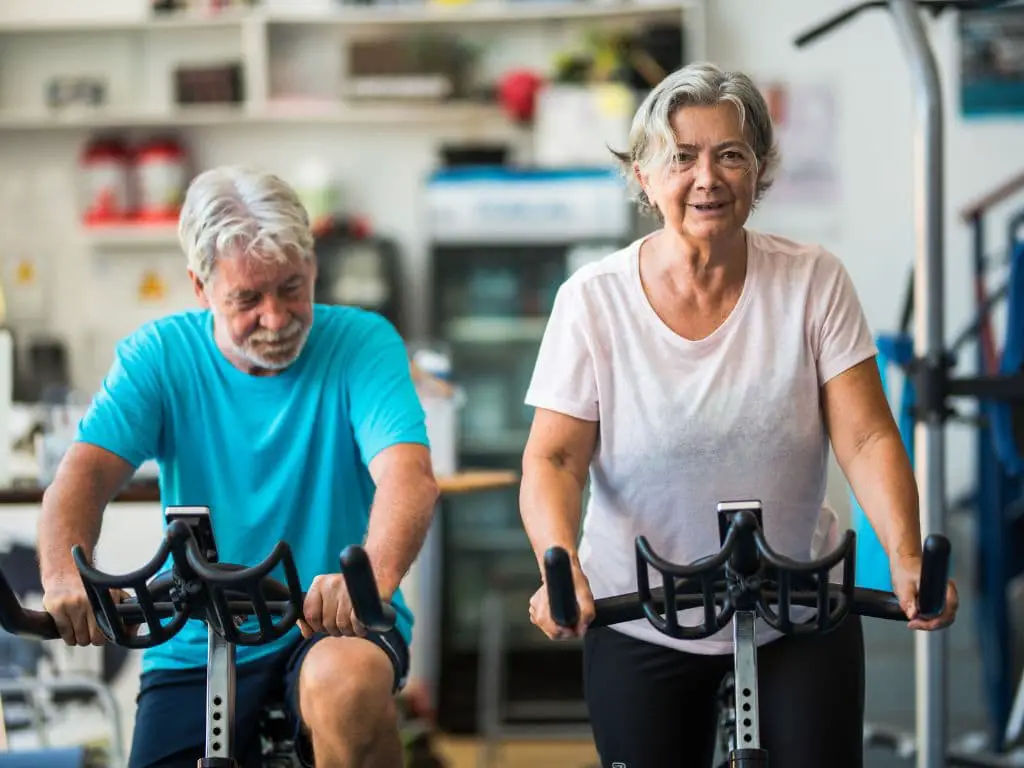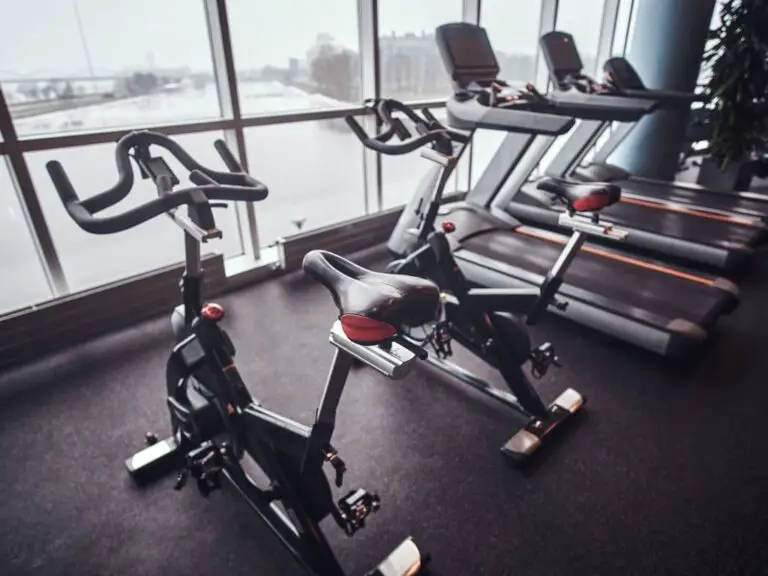Recumbent vs Upright Bike: Comparing Benefits, Risks, and Uses for Seniors
Staying physically active is important at any age. For seniors, finding the right type of low-impact exercise can help improve strength, balance, and cardiovascular health while reducing the risk of injuries. Recumbent and upright stationary bikes are two excellent options to consider.
The main difference between a recumbent and an upright bike lies in their design and the workout they offer. A recumbent bike has a reclined seat position, providing lower back support and reducing joint stress, ideal for low-impact workouts. An upright bike mimics traditional cycling with an upright posture, engaging more muscle groups for a more intense workout.

What Is a Recumbent Bike?
A recumbent bike has a reclined frame and seat that distributes the rider’s weight more evenly across the body. The pedals are positioned out in front of the body rather than below the seat.
The reclined seating position helps take pressure off the lower back and sensitive areas like the tailbone. Many recumbent bikes also have adjustable seats and backrests for additional comfort.
Recumbent bikes allow users to maintain a semi-reclined position while still getting an effective cardiovascular workout. This makes them ideal for seniors or those with back pain, arthritis, or other mobility limitations.
What Is an Upright Bike?
An upright bike has a vertical frame and seat similar to a traditional outdoor bicycle. The pedals are positioned directly below the seat.
Riders must support their upper body while maintaining an upright posture. This engages the back, shoulders, arms, and core.
Upright bikes provide a riding experience that closely mimics outdoor cycling. The upright position also leads to a more intense workout by recruiting more muscle groups.
Comparing the Features of Recumbent and Upright Bikes
There are some key differences between recumbent and upright stationary bikes:
1. Seat Comfort
- Recumbent bikes have padded bucket seats with backrests for superior comfort and support.
- Upright bikes have smaller seats without back support, requiring riders to engage their core.
2. Workout Intensity
- Recumbent riding is lower impact and gentler on joints. Ideal for lightto moderate exercise intensity.
- Upright riding engages more muscles for a more intense cardioworkout.
3. Targeted Muscle Groups
- Recumbent bikes target leg muscles like the quadriceps, hamstrings, and glutes. Less core and upper body engagement.
- Upright bikes work the legs, glutes, core, back, and arm muscles.
4. Safety Considerations
- The reclined position on a recumbent bike provides greater stabilityand reduces the risk of falls.
- Upright bikes require balance and coordination to avoid tipping.
5. Space Requirements
- Recumbent bikes have a longer frame and larger footprint.
- Upright bikes are more compact and take up less space.
6. Price Range
- Quality recumbent bikes start around $500-600. High-end models can cost over $2000.
- Basic upright bikes start around $200-300. Advanced models run $1000+.
Now that we’ve compared the key features, let’s examine the specific benefits of recumbent and upright stationary bikes.
Benefits of Using a Recumbent Bike
Here are some of the biggest advantages of recumbent bikes for seniors:
1. Lower Back Support
The reclined position minimizes pressure on the lumbar spine and intervertebral discs. This makes recumbent bikes ideal for seniors suffering from back pain or spinal conditions.
2. Less Stress on Joints
Recumbent riding is low impact and reduces strain on sensitive joints like the knees, hips, and ankles compared to upright cycling. Great for seniors with arthritis.
3. Comfortable Seating Position
The padded seat and backrest enables seniors to cycle comfortably for extended periods. Recumbent bikes make it easier for older adults to meet recommended exercise times.
4. Ideal for Rehabilitation
The reclined position allows seniors to maintain a safe, stable position while gently exercising. This makes recumbent bikes perfect for rehab and increasing mobility after injuries or surgery.
However, there are some potential downsides to consider with recumbent bikes:
- Limited upper body engagement – may lead to imbalance or postural issues over time
- Difficulty getting on/off the wide seat
- Reduced calorie burn compared to upright cycling
- Higher price point than basic upright bikes
- Large footprint – may not fit smaller spaces
Benefits of Using an Upright Bike
Upright stationary bikes also have advantages that may appeal to some seniors:
1. Mimics Road Cycling
The upright position engages the core and upper body similar to outdoor riding. Helps seniors build functional fitness.
2. Engages More Muscle Groups
Upright cycling works the legs, glutes, back, shoulders, arms and abs. Great for total body training.
3. Higher Calorie Burn Potential
The intense cardiovascular workout from upright cycling can help seniors burn more calories.
However, upright bikes do come with some potential downsides:
- Can put extra stress on the lower back and spine
- More strain on the knees, hips, and shoulders
- Standard seats may be uncomfortable for prolonged cycling
- Difficulty balancing and greater risk of falls
- May be too challenging for seniors just starting to exercise
Choosing Between a Recumbent and Upright Bike
So which type of stationary bike is better for seniors? Here are some key factors to consider:
- Physical limitations – upright bikes may be too intense for seniors with severe arthritis or back problems.
- Goals – upright bikes maximize calorie burn while recumbent bikes provide gentle exercise.
- Comfort – recumbent seats provide superior back support.
- Space – recumbent bikes have a larger footprint.
- Budget – uprights start at a more affordable price point.
- Safety – recumbents reduce the risk of loss of balance or falls.
Test out both types of bikes to see which feels most comfortable while providing the ideal workout intensity. Consulting a doctor can also help determine the safest, most beneficial option.
How to Use a Recumbent or Upright Bike for Maximum Benefits
Here are some tips to help seniors safely get the most out of stationary cycling:
- Adjust the seat to the proper height – there should be a slight bend in the knee at full extension.
- Add cushioned seat pads, gel covers, or a towel for extra comfort and support if needed.
- Maintain good posture while riding – avoid slouching or rounding the shoulders.
- Stay hydrated by drinking water before, during and after cycling.
- Engage in some light stretching before and after sessions to enhance flexibility.
- Start slowly and gradually increase workout duration as fitness improves.
- Add gentle resistance to build leg strength using the tension knob.
- Try interval training by alternating between higher and lower intensity.
- Monitor heart rate to keep it in the target zone for your age and fitness level.
- Cool down after workouts by cycling at a relaxed pace for 5-10 minutes.
For seniors new to exercise, consult a doctor to determine safe workout frequency, intensity and duration. Allow time for the body to adjust to avoid overexertion or injury.
Whether you choose a recumbent or upright stationary bike, cycling is a low-impact exercise option that can help seniors build endurance, strengthen muscles, and improve cardiovascular health. Paying attention to safety, using proper form, and slowly increasing workout difficulty will allow you to gain the most benefits from this accessible, senior-friendly aerobic activity.
Frequently Asked Questions
-
What’s the difference between a stationary bike and a recumbent bike?
A recumbent bike has a reclined frame and seat, distributing the rider’s weight evenly across the body with pedals in front, offering lower back support and less joint stress. An upright bike has a vertical frame and seat like a traditional bicycle, requiring upper body engagement for balance, providing a more intense workout.
-
Is a recumbent bike better for your knees?
Recumbent bikes are safer for the joints and easier on the knees. The recumbent bicycle is better for those with chronic knee pain. The recumbent bike is low-impact and can strengthen the muscles without straining. It won’t cause you to lose your balance.
-
How do I choose an exercise bike?
Look for upright bikes with easy to use displays if you feel that an exercise bike is the right choice. Make sure your bike tracks resistance, speed and distance. Some models include programs that can keep you motivated and changing your routine.
-
Is 3 miles on a stationary bike the same as walking 3 miles?
Many fitness professionals who calculate calorie loss for these exercises use time rather than distance. Reputable scientists have shown that bike riding is at least as effective as walking under similar conditions.
-
Who should use a recumbent bike?
Recumbent bikes have been shown to be beneficial to people with heart problems, according to a 2017 study. The recumbent bikes’ low position makes them more accessible to people with mobility problems and those using wheelchairs.
-
How long should a 65 year old ride a stationary bike?
The World Health Organization recommends that seniors 65 years and older should be doing at least 150 minutes of moderate intensity aerobic exercise per week. Simpson suggests that seniors start cycling three times per week, each for 20-30 minutes.
-
Why are recumbent bikes not popular?
Two-wheeled recumbent and outdoor riding bikes are also available, but these two-wheeled models don’t appeal to older riders due to balance problems. Tricycles with three wheels are also available. They’re known for having large seats.
-
What is the best type of exercise bike for seniors?
Sunny Health & Fitness SFRB4616 Magnetic Recumbent Exercise Bicycle is one of the most popular recumbent bikes. The bike is easy to operate, sturdy, smooth, and durable. There are eight levels of magnetic resistance on the bike, which is ideal for weaker and deconditioned riders.
-
Is walking or exercise bike better?
Cycling burns less fat than walking. It could be that walking is considered to be a weight-bearing exercise, while biking isn’t.
-
What are recumbent bikes good for?
Recumbent bikes allow you to work your glutes, calves and thighs with much less effort. The recumbent bike has a higher and wider seat than the upright one. Recumbent bikes are also less stressful on the joints. This is great for people with arthritis.






